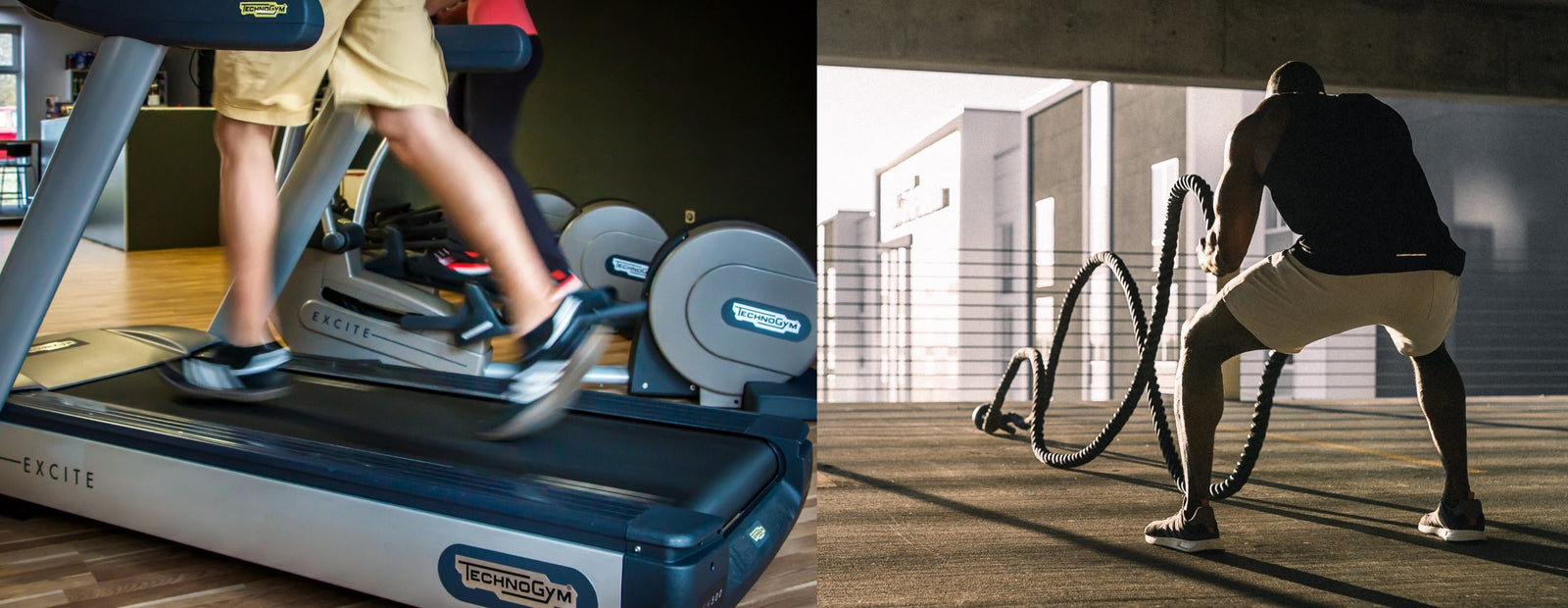BEST FORMS OF CARDIO FOR FAT LOSS AND PRESERVING MUSCLE

Best Forms of Cardio for Fat Loss While Preserving Muscle: A Lifestyle Guide
If your goal is to lose fat while preserving muscle mass, choosing the right forms of cardio is critical. You want to prioritize activities that burn calories and body fat without excessively stimulating cortisol (a stress hormone that can lead to muscle breakdown when elevated for long periods). Additionally, focusing on low-impact forms of cardio will minimize wear and tear on your joints, especially if you plan to do them regularly over the long term.
Below, we’ll cover two main types of cardio: steady state cardio and high-intensity interval training (HIIT). Both have their pros and cons, but when used correctly, they can complement each other and maximize fat loss while helping you maintain lean muscle mass.
Steady State Cardio
Best for: Long-duration fat burning with minimal muscle fatigue.
Stay within your “fat burning zone” while performing steady state cardio to maximize fat as your primary fuel source. Use the calculator below to find your zone.
1. Incline Treadmill Walking
Walking on an incline treadmill is an excellent form of low-impact cardio. It elevates your heart rate while keeping stress on your joints minimal. The incline adds resistance, helping you burn more calories than flat walking, and it targets muscles like the glutes, hamstrings, and calves.
Duration: 30-60 minutes
Intensity: Low to moderate (maintain a steady pace)
Benefits: Long, sustained fat-burning periods; less stress on the body; great for daily use.
2. Elliptical
The elliptical is another low-impact machine that allows for a full-body workout. The smooth, gliding motion minimizes joint stress while targeting both upper and lower body muscles. It’s a great option for those looking to stay active without over-stressing their knees or hips.
Duration: 30-60 minutes
Intensity: Low to moderate
Benefits: Full-body engagement; minimal impact on joints; suitable for extended cardio sessions.
3. Stairmaster
The stairmaster mimics the action of climbing stairs, providing a more intense lower-body workout. It burns a significant number of calories while primarily targeting the glutes, hamstrings, and quads. Since the movement is low-impact, it’s easier on your joints, making it a sustainable long-term cardio option.
Duration: 20-45 minutes
Intensity: Moderate
Benefits: Targets lower body; higher calorie burn due to climbing motion; low impact.
4. Rowing Machine
The rowing machine engages nearly every muscle group in your body—legs, core, and arms—while providing a low-impact, high-calorie burn. It’s excellent for building endurance and can be adjusted for various intensity levels.
Duration: 20-40 minutes
Intensity: Moderate
Benefits: Full-body workout; low impact; effective for improving cardiovascular endurance and muscle tone.
5. Cycling (Outdoor or Stationary Bike)
Cycling is another great low-impact option that can be done outdoors or on a stationary bike indoors. It targets the legs—quads, hamstrings, and calves—and can be sustained for long periods, making it ideal for steady-state cardio. Outdoor cycling can add variety and fun, while stationary bikes offer consistent resistance and easier monitoring of intensity.
Duration: 30-60 minutesIntensity: Low to moderate
Benefits: Low-impact on joints; great for lower body development; can be done indoors or outdoors; excellent for building endurance while burning fat.
Fat Burning Zone Heart Rate Calculator
HIIT Cardio (High-Intensity Interval Training)
Best for: Quick, time-efficient fat loss with higher calorie burn in a shorter time frame.
HIIT involves short bursts of intense exercise followed by periods of rest or low-intensity activity. Because of its intensity, HIIT is very effective for fat loss and maintaining lean muscle. However, it should be used sparingly to avoid overtraining or muscle loss due to its higher cortisol response.
Duration: 15-30 minutes
Intensity: High (alternate between max effort and rest)
Benefits: Extremely time-efficient; boosts metabolism for hours post-workout (afterburn effect); preserves muscle better than long-duration cardio.
Some common forms of HIIT cardio include:
1. Sprint Intervals
Alternate between sprinting and walking or jogging.
Example: Sprint for 20-30 seconds, walk/jog for 60 seconds. Repeat for 10-20 minutes.
2. Bike Intervals
On a stationary bike, alternate between high resistance/fast pedaling and low resistance/easy pedaling.
Example: 30 seconds of intense pedaling, followed by 90 seconds of light pedaling.
3. Battle Ropes
A full-body HIIT workout using ropes. Slam the ropes with maximum effort, then rest.
Example: 20 seconds of rope slams, 40 seconds rest. Repeat for 15-20 minutes.
Key Considerations for Cardio and Fat Loss
1. Steady State vs. HIIT
Steady-state cardio allows you to burn calories from fat while avoiding muscle fatigue, making it ideal for longer sessions. HIIT is a great fat-burning tool but should be performed in shorter durations to prevent excessive cortisol production, which can negatively impact muscle retention.
2. Frequency
For fat loss and muscle preservation, balance is key. You can do steady-state cardio more frequently, 4-6 days per week, without overwhelming your body. On the other hand, limit HIIT sessions to 2-3 times per week due to their intensity.
3. Low-Impact Focus
Low-impact cardio (like incline walking, elliptical, and rowing) reduces the risk of injury and ensures longevity. If you plan to integrate cardio into your routine long-term, it’s crucial to choose forms that won't lead to joint or muscle strain over time.
4. Caloric Deficit
No matter what type of cardio you choose, creating a caloric deficit (burning more calories than you consume) is essential for fat loss. Steady-state cardio, due to its lower intensity, tends to rely more on fat as fuel, making it a valuable tool in your fat-loss toolbox.
Conclusion
To lose fat while preserving muscle, focus on a blend of steady-state cardio and HIIT. Steady-state cardio can be performed longer, providing a sustained fat-burning effect, while HIIT gives you a shorter, high-intensity burn. Incorporate low-impact forms of cardio like the incline treadmill, elliptical, and rowing machine to protect your joints and ensure you can maintain your routine long-term.

